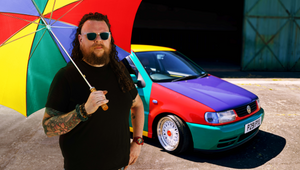
Running on Instinct: Behind PUMA’s Most Ambitious Brand Move Yet

As PUMA unveils ‘Go Wild’ – its most ambitious brand platform to date – the global sportswear giant signals an evolution for its identity.
With instinct, joy and emotional truth (gathered from over 10,000 real runners) at the core, ‘Go Wild’ moves beyond the traditional performance-led tropes of the category, inviting people to embrace the unfiltered rush of sports. Kicking off with a running-led hero campaign, the work celebrates the everyday runner – from new mums to 6am risers – and the euphoric highs that come with the hard miles.
Crafted by adam&eveDDB, the campaign leans into PUMA’s heritage of individuality and expression, while at the same time, setting a fresh creative tone for the brand moving forward. Shot on 16mm by director Elliott Power, the launch film favours intimacy over spectacle, capturing those quiet, powerful moments of transformation that happen mid-stride and long after the finish line.
LBB’s Zoe Antonov sat down with Jack Spicer, planning director, and Mark Shanley, executive creative director at adam&eveDDB, to unpack the insights, challenges and creative thinking behind the campaign
LBB> What was the initial creative spark or insight that led to the ‘Go Wild’ concept, and how did it evolve throughout the campaign’s development?
Jack> PUMA was trying to get back to the heart of the brand, which is that it has always championed individual athletes – not just individual athletic brilliance, but brilliant personalities. It built this new brand strategy on the idea that greatness begins with the courage to be yourself. All of the brilliant athletes that we love are big personalities – the ones who excel in their fields and are also unafraid to be themselves.
PUMA took that attitude to the layperson and encouraged them to be themselves on and off the pitch. We needed an expression of that which felt really true to PUMA, and then we jumped off that into the creative platform ‘Go Wild’.
Mark> I love ‘Go Wild’ for its brutal simplicity. The word ‘go’ is active – the same way ‘Just Do It’ tells you to do something – but it’s underutilised. You say it in every sport. You shout “Go” at a Formula One driver in the pits, at a football player or a runner or a basketball player. Meanwhile, ‘wild’ sums up the PUMA athlete. They are the wild ones – the square pegs in the round holes, the people who play their own game. What’s more, its logo is this big wild animal, so no one else can do wildness the way PUMA can; it is intrinsic to the brand’s DNA. ‘Go Wild’ was just there waiting for us to stumble on it. And we did.
LBB> PUMA is positioning itself at the intersection of performance and joy – how did you balance these two elements in the campaign’s messaging and creative execution?
Mark> The campaign focuses on what we call the runner’s high: the way you feel after you’ve been on a run, whether it’s a race or a slog to the top of a mountain. Perhaps you’ve got to the end of the marathon and you feel terrible, but you still have that runner’s high. It's the feeling when you get to the end when you're exhausted, but it feels amazing.
So, this is about performance, and it’s also about the joy, inspiration and excitement you feel after a good run.
Jack> PUMA is building credibility in the performance of its products and how they help people succeed, but it also needs to be distinctive in the way that it communicates. The performance sports category is very serious. Everything is about winning and success. We wanted to explore the much more playful aspects of sport in a way that would make people smile – something less aggressive than the other brands.
LBB> The campaign moves away from featuring celebrities and instead focuses on everyday runners—what was the reasoning behind this decision, and how did you ensure it would still resonate with a broad audience?
Mark> Athletes are a key focus for PUMA, but this campaign is talking to runners and is, hopefully, more relatable; everyone can relate to a mum who has to take her child in the buggy on her run, or the woman who's trying to get a run in before work, or a guy who's running to work.
The average person who's running twice a week might not know the names of high-performing athletes, but they do know how good a run feels. So, we wanted to zero in on that feeling.
LBB> How did you visually and emotionally capture the sensation of the “runner’s high” in the hero film and other creative assets?
Mark> The spot is shot on 16 millimetre film, which you don't see a lot anymore, but it's a great way to get a more authentic feel in the work. It feels more real and less digital. There's something tangible about the film – it just feels more realistic. It’s quite an intimate way of shooting.
The film opens on someone waking up. It looks completely different to other running ads. The director, Elliott Power, did an amazing job of getting the camera into the more intimate moments on a run. It’s not the typical big, cinematic shots of sweeping, wide, open planes, and we don't see the race. We see the end of the race when a woman is feeling the runner’s high – she's feeling completely empty, but also amazing. It was about capturing those intense, personal moments when she meets her partner at the end of the race, rather than just seeing her run the race, which we've seen a thousand times before.
We wanted to take a fresh look at running – the way it is so hard before you start, and how it feels amazing afterwards. So we didn’t want to focus on the actual run, but that emotional journey from hard to high.
LBB> What were the biggest creative or logistical challenges in bringing this campaign to life, particularly with it being PUMA’s largest marketing investment to date?
Mark> The creative challenge was making it feel like a global campaign. I've seen lots of comments under the film on social media where people say, “I spotted Brighton”, or “I spotted Cape Town”, but in fact, it was all shot in and around Cape Town. The team used very clever production techniques to make it look as though it could be anywhere globally. We had to be smart with the locations, and not have too many landmarks that are identifiable as a specific place. I think we did a good job.
The other challenge was the casting. It was vital that we cast authentic runners. If they were not a legitimate runner, the real runners would see right through them.
We had a running coach on set, but all of the runners were cast for their ability as runners, first and foremost.
LBB> Given the diverse global markets PUMA is targeting, how did you ensure cultural relevance while maintaining a unified brand message?
Mark> We hope that wherever you live and wherever you’re from, there is someone that represents you and a place that looks familiar. We wanted everyone to relate to the runner's high.
There will also be local activations on the ground globally, around race days and with local running clubs, and in stores and on social media. The campaign is huge and sprawling beyond the film, which is the beating heart of the work. But each market will have its own version of the assets.
LBB> This campaign was built on the largest consumer research in PUMA’s history – were there any surprising insights that shaped your creative approach?
Jack> For the research, it interviewed 10,000 consumers across the globe. And it found that most sports advertising was trying to maximise the performance aspect of a brand – the brand will help you to run faster, jump higher, score more goals. But it also found that most people are running not necessarily to win, but because it makes them feel good. And also, that people are buying running shoes because they like the look of them, and they make them feel stylish.
The big unlock from this was that we could move away from having to talk about running faster with PUMA, and start talking about how running feels incredible with PUMA. This is a ‘truth’ – people are not just running for performance, they are running to feel amazing. And that was what we needed to focus on.
LBB> Gen z is a key audience for ‘Go Wild’. How did their values and digital behaviours influence its storytelling, tone, and media strategy of the campaign?
Jack> Trying to capture a younger generation is really important for lifestyle sports brands, because youth lead the way in defining what is stylish. We were aiming younger, but we needed an idea that could ladder up to an older runner. The campaign also needed to be flexible and compelling on TikTok and Instagram Reels.
A runner might follow running influencers, doing their daily workouts and setting them to music. The campaign needed to be at home in those channels as well. So, in addition to creating specific social edits, we produced CapCut templates for Instagram and TikTok that mimicked the ‘I was going do X, but then I got high’ structure from our AV asset. Puma then recruited over 300 running influencers from across the globe to create their own personalised edits.
LBB> How does ‘Go Wild’ represent a shift in PUMA’s brand identity, and what signals should consumers expect to see in future campaigns?
Mark> PUMA’s brand identity manifests in this film and it’s going to infuse everything we do. I'm really excited about the other sports,showing what ‘wild football’ is, and how the campaign breaks with convention. ‘Go Wild’ is about unleashing what's within you. From a creative point of view, when we get to execution, it's a really exciting platform to be able to infuse into all the different executions for a variety of sports.
Jack> PUMA is honing in on what it’s good at, which is celebrating expressive, fun and convention-defying athletes. The brand loves the personalities of the sport, and we’re working with its team to get back to that celebration of the individual.
LBB> The campaign tested exceptionally well in pre-launch studies – what specific metrics or KPIs will determine its success in the real world over the next year?
Jack> Broadly, we need to raise awareness and consideration among runners about PUMA as a performance brand.
It scored strongly in pre-testing on System1, which is a methodology that aligns with my values around emotional advertising. It's also scoring above five stars across all of our markets. So, we’ve got evidence from pre-testing that our approach works. It is based on a universal insight that translates into different markets, with an emotional hook at the heart of it.
LBB> Given the long-term vision for ‘Go Wild’ extending into 2025/26, how will you keep the message fresh and engaging as it expands into other sports like basketball and football?
Mark> I think it's about keeping ‘Go Wild’ at the forefront of all the work, because it's a really fresh approach. You can imagine what the platform will allow you to do in basketball, or on a football pitch. I think we just have to keep our eyes on the prize, and make sure all the work has ‘Go Wild’ at the heart of it, and it will feel fresh.
Jack> I would love ‘Go Wild’ to be the real North Star for PUMA’s advertising for years to come. It's all about instinctive performance and personality. And it’s a platform that helps the different business units within PUMA make sense of what they're doing.
‘Go Wild’ is an idea that we can bake into PUMA at every level. And if we can do that, then it'll become self-reinforcing and keep going.















